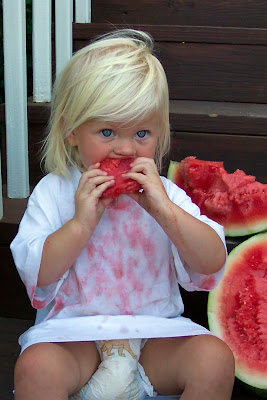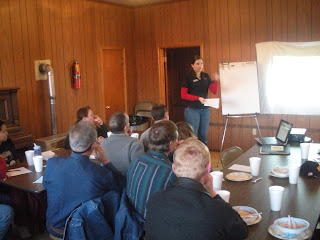Today we welcome back Kathy of H&K Farms. Kathy has shared her story on this blog before, but is returning today to tell the story of her son and his place in agriculture as a tribute to his 18th birthday.
 |
| Summer 1995 - Planting with dad at 8-months-old |
Like many rural kids, when Cody turned 8, he joined 4-H, which was 10 years ago this September. He went to his first 4-H meeting which was on his 8th birthday. How appropriate that the first meeting of his last year in 4-H also falls on his birthday. Through 4-H, Cody has learned many great life skills, from working with his cattle, to welding, working on a small engine, and in later years, running the meeting as president and supervising a cabin full of campers as counselor. He’s not 100% sure what he wants to major in, in college; but 4-H has given him so many great building blocks on which to start.
 |
| Summer 1999 - Trying out dad's pedal tractor, age 5 |
As Cody got older, he began helping his Dad and Grandpa on the farm. Basic beginner jobs, like raking hay, picking up square bales and evening feeding were his jobs. In the last few years, he’s driven and dumped grain trucks, did some of the planting, and helps with silage chopping. We sell seed corn and Cody always helps his dad organize the varieties and plant the test plot, which is a tedious job. Cody’s attention to detail and making sure everything is lined up as it should be are a great help to his dad.
 |
| Summer 2003 - Showing an angus steer, age 9 |
In the showing of cattle, Cody is growing his herd of registered Angus cows. Out of one of his first show heifers, he raised and sold a bull. He has saved a nice nest egg towards college through the sales of his steers and other 4-H projects over the years. He has also made a wonderful network of friends through showing cattle. Of course he didn’t realize it at the time, but those kids he played and hung out with over the years will be tomorrow’s business contacts. In fact he already works with some of those kids in his hay hauling business.
As is the natural progression of things, when Cody got to high school, he joined our local FFA chapter. Through FFA, he’s broadened his skills through contest teams, meeting more friends and has been able to share his story with many more people. The chapter sells fruit each fall to raise money to attend the National Convention. In meeting and doing business with the 60 or so people he sells to, he’s had the opportunity to share parts of his day to day life with people he would have never known before, and through him, several more people see the future of agriculture in that blue corduroy jacket. Through the chapter, he’s helped at the local food bank, done yard work for the local elderly and enjoyed exhibiting at local and state fairs.
 |
| Fall 2010 - FFA Awards, Grandpa won Chapter Hall of Fame |
After he turned 16, he decided that a ‘side job’ would be a great way to have that gas money throughout the school year. During the school year, outside of chores at the farm, it’s hard for him to have a ‘job’ as he plays two sports and is active in 4-H and FFA so there is not much time left to flip burgers or whatever else he might find. So my math minded kid, sat down and figured out that if he bought an older pickup, one that he could pay cash for and just needed the basic insurance and talked Dad into making a deal on a trailer, he could start a hay hauling crew. He has the perfect pool of guys to hire from, as he plays on the football team and has a coach who is more than happy to encourage the ‘town’ guys to go and get in some conditioning in the hay field. Through his business he’s learned to keep good books and be organized with his contacts. It’s been a good life experience dealing with other people, both the farmers hiring the crew and the guys on the crew. He’s had to be flexible; he’s taught other kids how to drive a manual transmission, he’s learned to pay attention to all else going on in the community. He found out the hard way that taking a job the week of the county fair, wrestling camp and 2 a day football is going on is tough - thankfully he found enough older and younger kids to get the job done. And that not everyone is willing to kill themselves in 100 degree heat in their off hours between practices. Some life lessons learned.
 |
| Summer 2012 - Stacking hay, age 17 |
Like most farm kids, Cody has many responsibilities around the farm. This summer for example, his mornings started earlier than even his dad. He went into weightlifting with the football team at 5am, 5 days a week, most of the summer. When he got back home, he worked with his dad all day, somedays he had practice or 7 on 7 league that evening, so he ‘got’ to quit early. If he wasn’t working with his dad, he was in the barn, preparing our show cattle for the fair season. The kids did most of the work in leading the calves, washing and clipping. Then there was his hay hauling, which with this year’s drought was basically done by the end of June. So some of his days started at 5am and ended well after midnight. He did get a couple of breaks this summer; we didn’t ‘work’ him all summer. He was the head counselor at 4-H camp, something that he’s went to, I believe, about every year since he joined 4-H, having been a counselor the last few years. We also exhibit at the Missouri State Fair, which we did this year as well. He did make a trip back home and catch a football practice while we were there.
He’s a dedicated young man. I know sometimes I even forget how many irons he’s got in the fire. He keeps it all going, some days I wonder how. Helps his dad on the farm, plays sports, keeps good grades in tough classes (he is taking many dual credit classes) and still manages to get enough downtime in that he stays pretty happy and satisfied and we do too. He may not realize it, but in keeping all this going, he’s learning a strong work ethic that will take him far in this world. His dad and I will be lucky and blessed if it takes him back home to farm, but we would be thrilled to watch him conquer the world, because we are pretty sure being raised a farm kid, he could do it!
Thanks for the fantastic feature Kathy! Seeing the future of agriculture in hard working young people like Cody is an inspiration to everyone. Be sure to check out Kathy's personal blog and Facebook page to learn more about her family.
If you or someone you know would be interested in sharing your story on this blog - please contact us! We need your stories to keep this blog going - no need to have a blog or facebook page, we would love to share everyone's story!














































